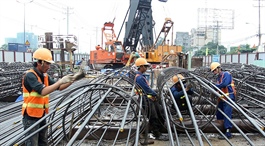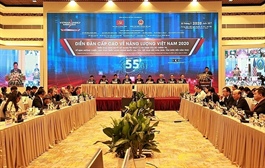Vietnam to benefit from supply chain relocations
Vietnam to benefit from supply chain relocations
The global health crisis is accelerating global trends in supply chain shifts, offering Vietnam possible development advantages on a silver platter. Vietnam Citi country officer Natasha Ansell shared her view with VIR’s Phu Canh on Vietnam’s economic outlook and its current position as a potential manufacturing hub in the region.

Vietnam Citi country officer Natasha Ansell
|
Following the reopening of the economy, what is your view on Vietnam’s economic outlook?
While growth in Vietnam is expected to decrease to 2.4 per cent in 2020, the economy is gradually showing signs of recovery with an expected rebound in 2021.
Tourism, hotel, retail, and transportation industries, which account for 20-25 per cent of GDP, are showing steady improvements although it will require a significant rebound in international tourism to boost these sectors back to pre-COVID levels.
Oil prices too have a significant impact on government revenue. Outside of Vietnam, global demand cutbacks are also having an impact. Shoes and garment exports of $46 billion, which account for 18 per cent of Vietnamese exports, have been affected by sluggish demand from the US and EU markets, where nearly half of these products go to.
Despite various points of pressure, Vietnam has been duly applauded for the way the country has handled the COVID-19 pandemic. By taking aggressive steps in early February, the country has kept its overall infection numbers to around 400, with zero casualties.
This has helped to prop up the domestic economy and travel as well. While we continue to monitor the health crisis and the ongoing uncertainty within the broader region and globally, we remain confident on Vietnam’s future prospects.
Supported by a growing middle class, consumer spending, and fiscal policies that encourage public spending, we expect to see further GDP growth.
This is a strong endorsement of the government’s ability to keep the pandemic under control while continuing to attract foreign direct investment into the market, despite an understandable slowdown in capital inflows during this time overall.
What are the levels and activities around banking and lending in this period?
Lending levels and other banking activities have varied during this time, depending on whether companies were managing supply-side or demand-related shocks.
In the initial stages of the pandemic, around February and March, many companies faced a bottleneck in the supply of raw materials due to factory shutdowns and border restrictions across multiple markets. This led to a reduction in loan demand.
As the pandemic progressed to other parts of the world, factories in the region, including in China, began to resume production. While supply chains are gradually normalising, activity did not return to full capacity given demand shocks from export markets such as the US and the EU.
With a focus on maintaining liquidity to support business growth, companies started to deploy loans with longer tenors during this period. We continued to use our balance sheet and strong liquidity position to support our clients, the majority of whom are foreign-invested companies, with strong fundamentals and support from their parent companies.
We are also seeing an increase in new loan facilities and requirements from corporates in the region that are expanding their supply chains to Vietnam and, as a result, expanding their production capacity here. We are partnering with our clients to facilitate these plans in the country while ensuring we are lending prudently and in line with our risk management policies.
What impact is COVID-19 having on supply chains and what implications does have for Vietnam?
COVID-19 is accelerating supply chain relocation plans for companies. The pandemic has exacerbated trends that were already visible due to geopolitical developments and the demands of changing business models.
With the pandemic, we expect supply chain shifts to occur at a quicker pace than previously anticipated. Vietnam stands to benefit from these shifts given an increasing interest in the country from companies which are keen to expand manufacturing capacity.
In recent years, a number of multinational firms have relocated parts of their supply chains to Vietnam as part of their diversification strategies. South Korea was the largest investor in Vietnam last year, pouring close to a fifth of the $38 billion in new foreign direct investment (FDI) into Vietnam. Hong Kong, Japan, and China were also amongst the top investors.
Vietnam represents a pro-business and liberal investment environment, with competitive cost structures and a wide range of tax incentives and tariff benefits resulting from multiple free trade agreements. This includes the Comprehensive and Progressive Agreement for Trans-Pacific Partnership and more recently, the EU-Vietnam Free Trade Agreement that aims to encourage new trade flows and, consequently, supply chains.
We believe that Vietnam has a significant potential to prosper from this opportunity, supported by government policies and interest in attracting FDI into the market.
What are the hurdles that may prevent supply chains from moving to Vietnam and what more can be done to take advantage of the trend?
To capitalise on the opportunity of shifting supply chains, Vietnam will need to continue to develop its infrastructure and build up its capacity. Relative to other markets, Vietnam’s GDP is small and, on a per capita basis, it is still below many developing countries. Labour supply is moderate and the logistics, as well as transportation infrastructure, needs to be further developed.
Focus on further developing the road network, port infrastructure, industrial parks, and utility supply would be critical for Vietnam to continue being competitive in attracting FDI.
Specifically on infrastructure, Vietnam must develop its infrastructure more quickly, especially in Ho Chi Minh City and its surrounding areas.
According to the World Economic Forum’s Global Competitiveness Report 2019, Vietnam ranks 67th out of 141 in terms of overall quality of infrastructure, 103rd in quality of roads, and 83rd in quality of port infrastructure.
The government must further emphasise the improvement of industrial zones, transportation networks, and power projects. To solve traffic congestion problems in large cities, the government should facilitate major public transportation projects.
Those actions would be very important for the country to continue to establish Vietnam as a prominent regional manufacturing hub in Asia.






















